Kimchi Making #2
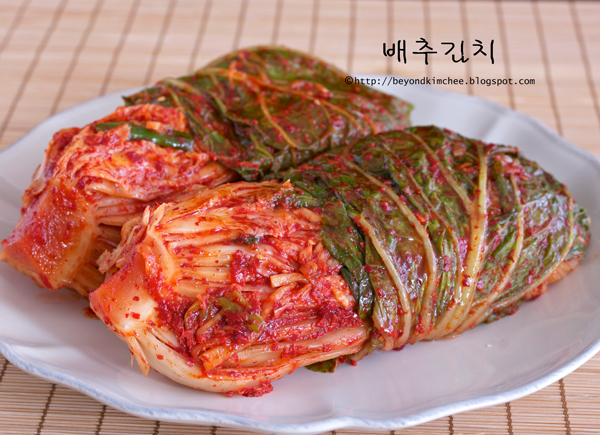
Welcome back to my Kimchi (Kimchee) school. We are entering the second session of Kimchee making. In the first session, you learned about salt brining the cabbage.
In a previous post I have explained how to soak the cabbage in the salt water solution, which is the most important part of Kimchee making. If you master that process you can graduate Kimchee school with an honor degree, the Kimchee Cum Laude.
Today I will show you how to make the cabbage stuffing.
We call the stuffing, Kimchee Soh (김치소).
They are the sidekicks of the show, which makes the look and the taste. They are the ones who makes the important final touch. Just like the impressive supporting actors or actresses who adds the real kick in the movies, this Soh makes the Kimchee to another level.
FACT : Did you know that Kimchee(Kimchi) was originally white, not red? Koreans have been making Kimchee for over 1000 years but never been spicy, which means no chilies had been used. Chilies simply did not exist in Korea. The introduction of chili pepper in the 1800’s via Japan, which was from Portugal, of whom they got it from South America, changed the look of Kimchee. Japanese didn’t care much of chili when it was introduced by Portuguese but Koreans were the one who went nuts over. We love CHILI! Thanks to South America. In fact if you look into the history of some food, you will be amazed how many are originated from S. America. Columbus did not only contributed the course of world history but he also influence the cuisines of the world. I wonder what Europeans ate before the arrival of potatoes, because every restaurant I went in Europe served fries as a side.
Ooops! my lectures has detoured to somewhat different course. Sorry! Let’s come back to our original point and begin the class. Kimchee! here we come…
Chapter II : the Sidekicks
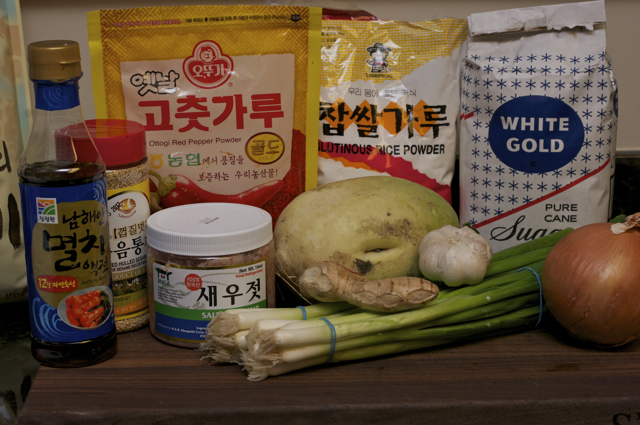
The supporting crews of the show. anchovy sauce, sesame seeds, Korean chili flakes, sweet rice powder, sugar, shrimp sauce(salted shrimp), Korean radish, green onion, ginger, garlic, onion.
Now,
Before I tell you how to prepare the sidekicks of the show,
I need to show you my hidden jewels of Kimchee recipe.
The sea quartets!
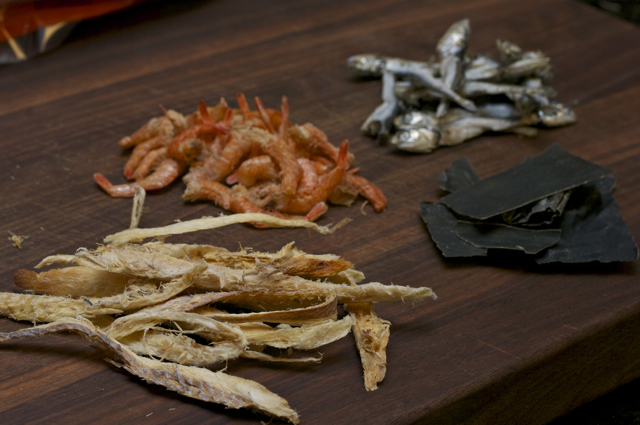
Pollock fish, shrimps, anchovies, sea kelp, all in dried form.
You can be creative and use your own choice.
If you have access to fresh fish head (such as cod or yellow croaker),
it will make gorgeous flavor to Kimchee. Weird?
Adding these sea flavor to Kimchee is one discovery that you won’t regret to adapt.
Trust me on this.
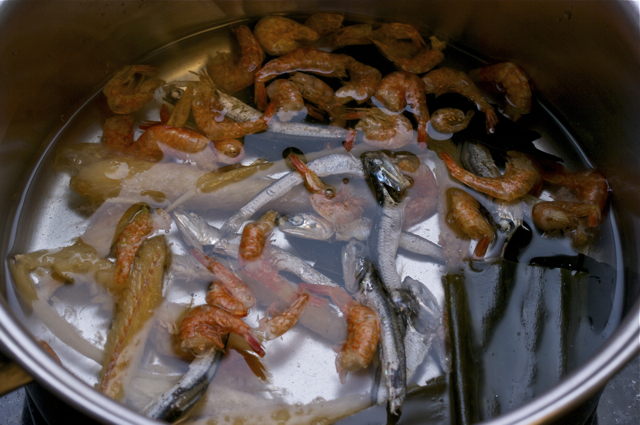
Put them all in a pot and add about 3 cups of water.
Boil and simmer for 10 minutes, covered. Let it rest for 20 minutes.
You need to make this stock real intensified.

Gorgeous! Strain the stock and reserve 2 cups.
You wan to separate this into 1 1/2 C to make rice glue + 1/2C for another use.
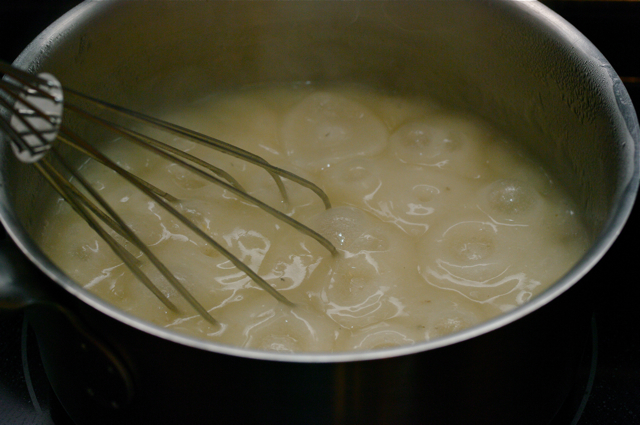
Pour 1 1/2cups of reserved stock into the sauce pan and add 2 Tbsp sweet rice flour.
Mix and boil to thicken whisking constantly, about 3-5 minutes. Let it cool You are making the rice glue. This will make the filling to be spreadable consistency and help bond to the cabbage better.
Do not try to taste this. It is disgusting now but will raise your Kimchee to a whole different level.
Now, let’s move on.
Make your knife to be proud.
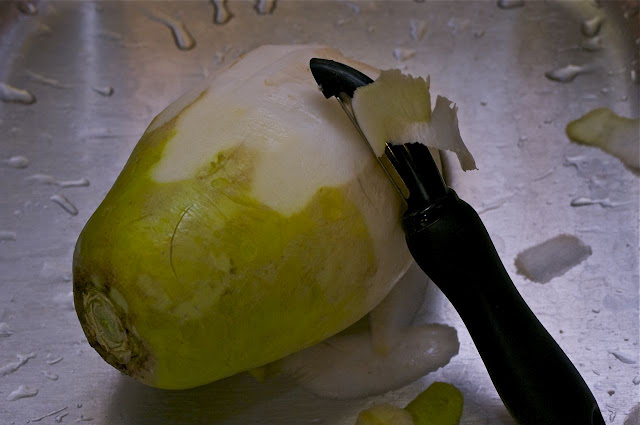
Korean radish!
Peel off her cloth. She performs better in nude.
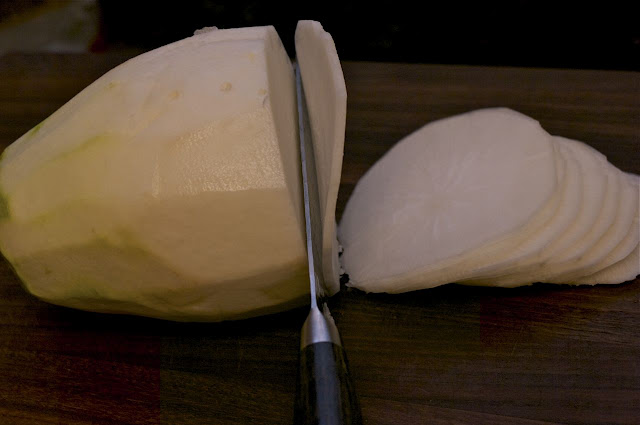
Slice her into 1/8″ thick.
It is okay if you made a few slices thicker or thinner. Nobody is perfect in this world.
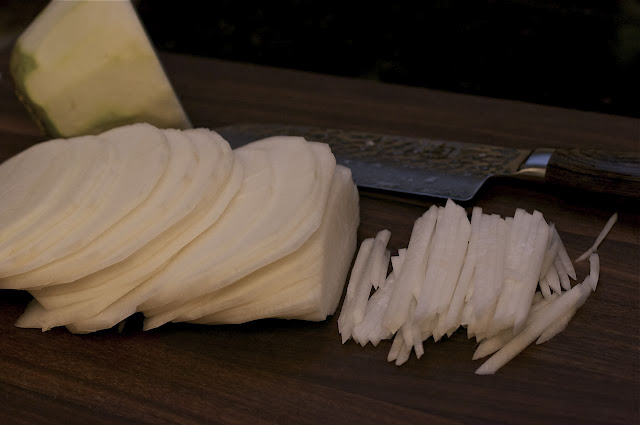
Cut them into 1/8″ sticks, just like that.
Why, oh, why on earth am I so good at slicing?
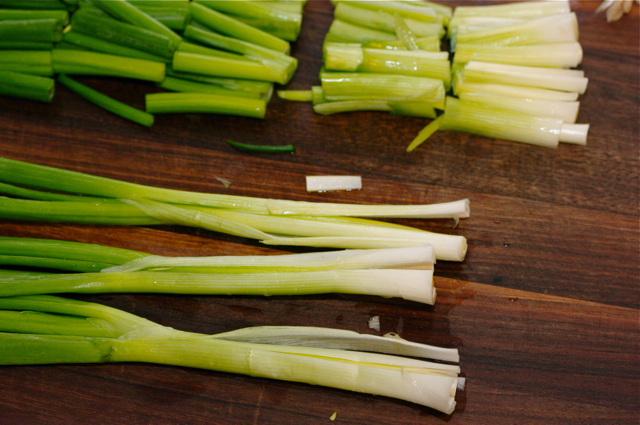
Cut the white part of green onion in half lengthwise and slice them into 1 1/2″ long.
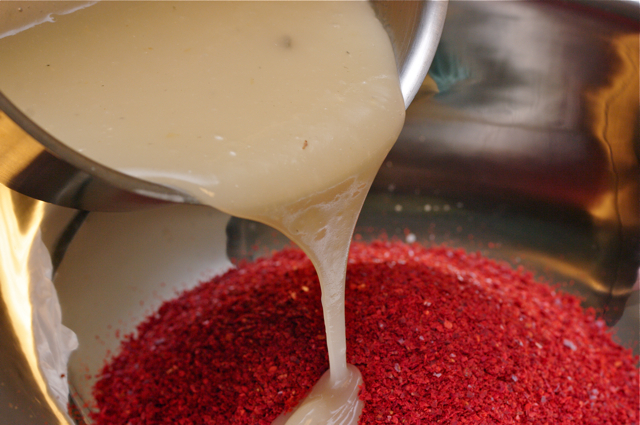
In a big bowl place 4 cups of Korean chili flakes and pour the rice glue.
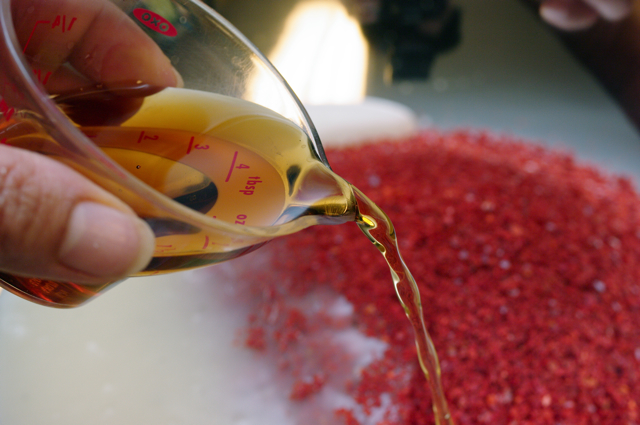
Add the anchovy sauce,
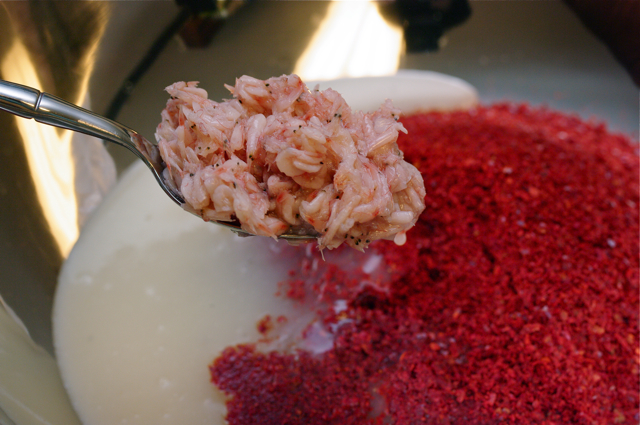
add these alien looking shrimp sauce, aka salted shrimp.
No need to chop them. They will eventually melt in the process. Aren’t you glad?
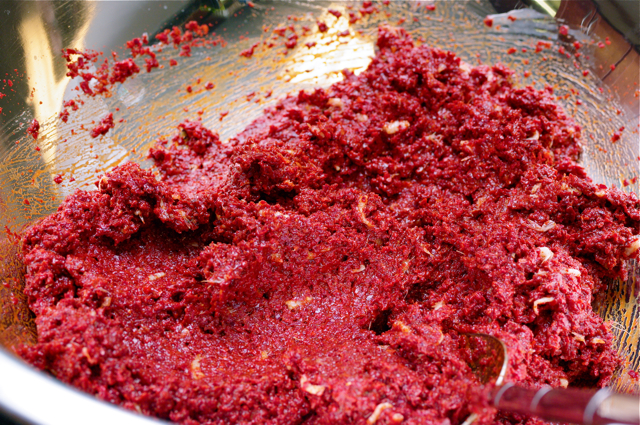
Mix together. It will be like thick paste.
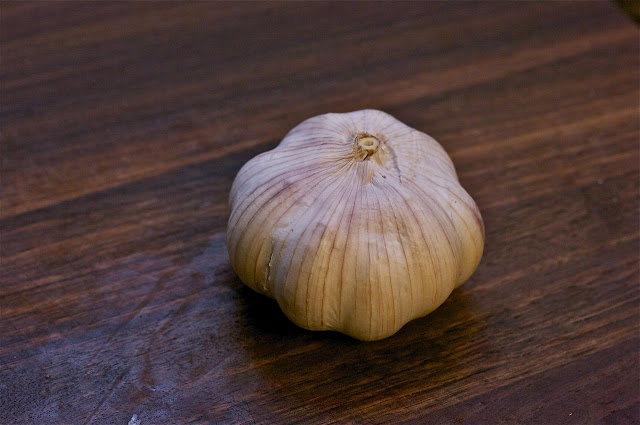
As you know, this is a garlic. They hold on each other like the United Nation.
How many lives can you get out of one head of garlic?
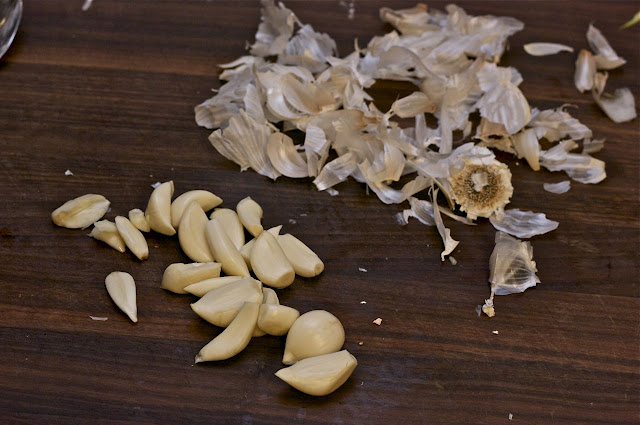
You count and let me know.
You will need about 10 cloves out of this pile.
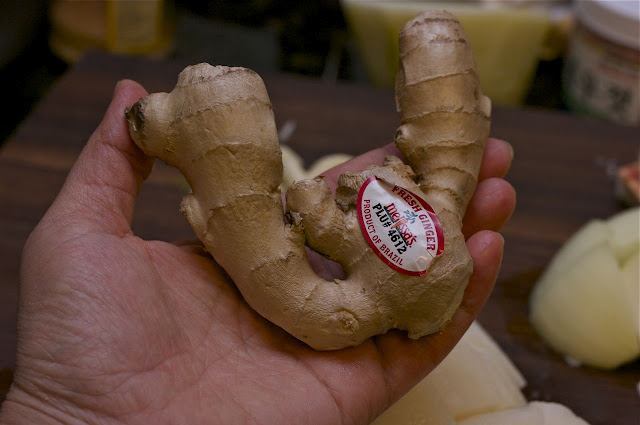
This is ginger. She flew all the way from Brazil to help me out.
Ola, Como Vai, Ginger?
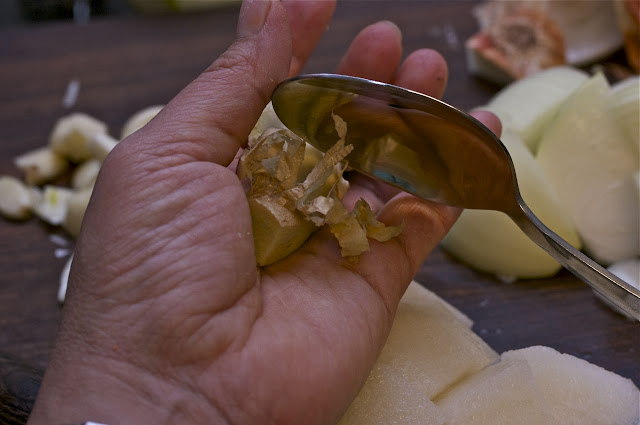
Cut 2″ long slice off from her and peel her with spoon. Roughly chop her.
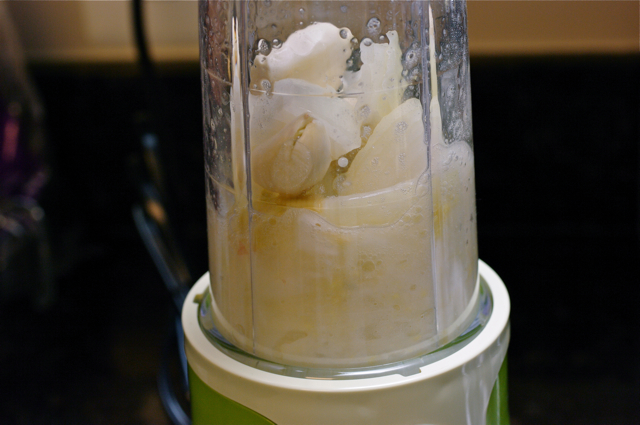
In a blender put diced onion, garlic, ginger and the reserved 1/2 cup of stock.
Puree their lives until smooth.
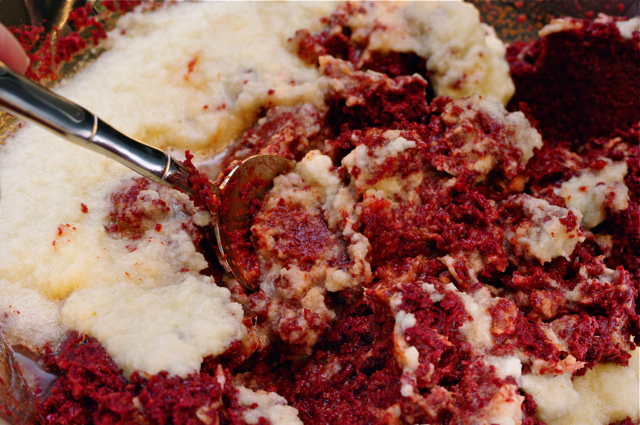
Mix in to the paste.
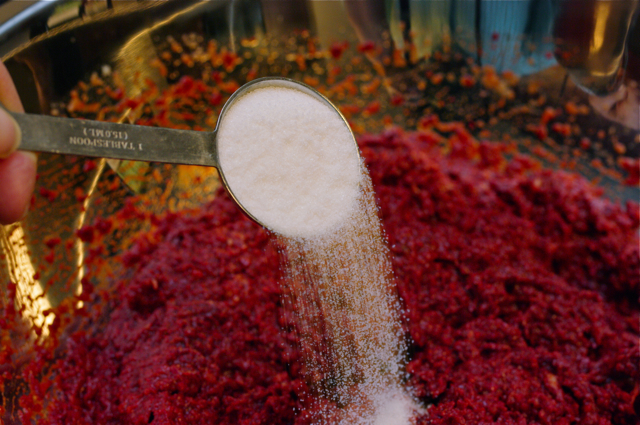
Add sugar and sesame seeds, mix.
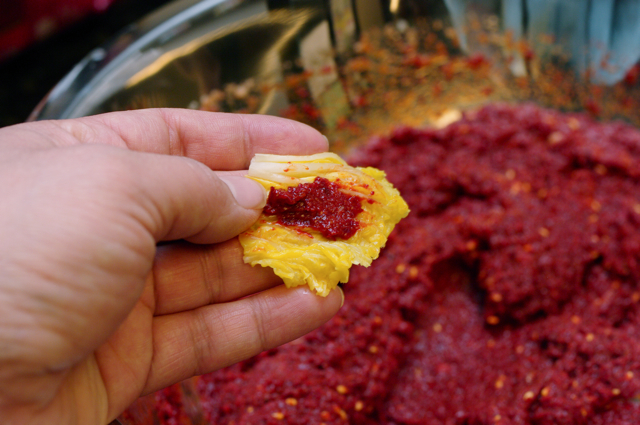
Take a little piece of cabbage and put some paste, EAT!
You need to test if the paste is rightly seasoned.
Depends on how much sodium level in your cabbage,
you might need to add more fish sauce or salt in this stuffing.
It should be slightly saltier than you would usually taste from other food.
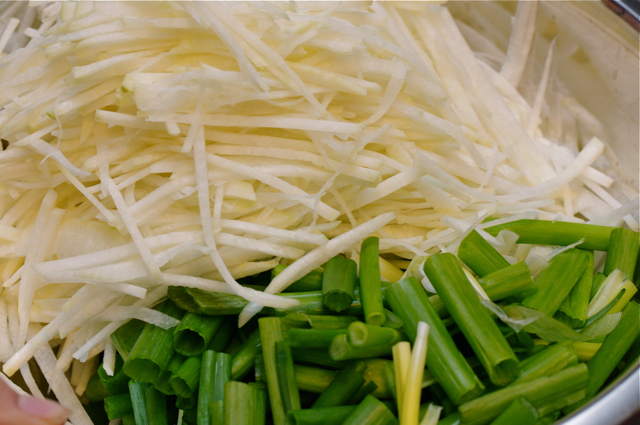
Remember the radish and green onions?
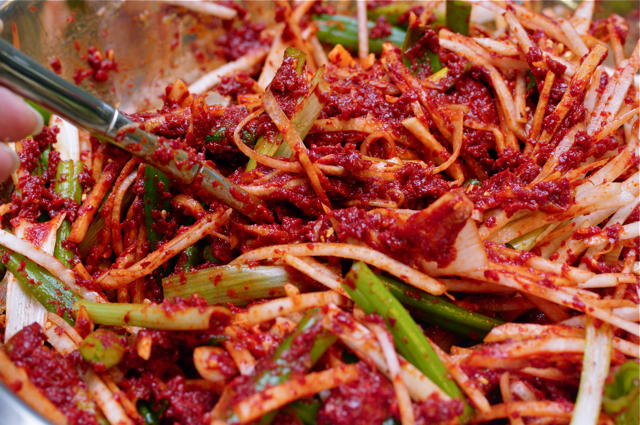
Mix them into the paste. You need to let this filling sit for 30minutes so that the radish will extract their moisture and get wilted. They are too stiff to use right away.
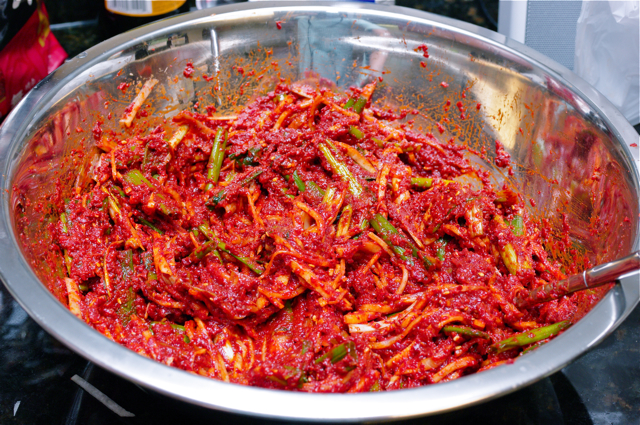
Now the Kimchee filling is created and well rested.
If you want to be more exotic at this point, you can add fresh shrimp, or fish to the filling.
(When I mean “fresh” it means alive, not dead. They have to stare at you and crawl in front of your eyes. I couldn’t find the live crawling shrimps nor jumping fishes at any grocery stores so I skip them)
Adding fresh sea creature might sound so bizarre to you, but that puts your Kimchee to rise above all.
Many Korean home cooks add that to the winter cabbage Kimchee and everyone loves it.
My mother always put fresh, clean cod pieces in the cabbage during winter time and I remember how good her Kimchee tasted.
Some add raw oyster instead and it makes Kimchee very refreshing, that’s what we call, but you can’t store too long with oyster. They get mushy and unpleasant after a while.
Well, well, well…
I need to end my second Kimchee post right here. My buns aren’t that tired this time and my kiddos are gone to bed, but I am hungry…
I better go eat some of my Kimchee with rice.
The photo on top is my Kimchee that has been fermented for about a week in my fridge.
It is too die for…
Can’t be compared with store bought. Not even close…I will come back again in a few days with the last chapter of this process.
Thank you so much for being patient with me.
It is so cold outside, keep yourself warm. Or if you live in tropical, stay cool!
With XOXO,
H


Thanks for this going to try it tonight. Btw the link to part 1 doesn’t work (but I found it with a search).
Can you please post more details and specific measurements regarding adding fresh seafood to kimchi? What kind of fish? What kind of shrimp? Specific measurements, etc.
Also, I read somewhere that in Korea, some people also add different types of meat (ie pork, beef, etc.) to their kimchi for extra nutrition, do you have any recipes on this?
제 어머니는 한국사람이예요. 그래서, 한국말로 대답해도 돼요.
I live in Venezuela, South America, far from Korea jijiji … It would be fantastic if you could explain the composition and the elaboration of Meju so I can do Gochujang. I have some molds and bacteria that I bought through the web and also a general idea of how to make some fermentations … I have not been able to find on the web a good explanation of how to prepare Meju that is of my confidence. All those pages are wasting a lot of time and effort … I appreciate your wise words and advice.
Greetings. His blogs look fantastic and I really liked his humor notes in the writing of the content. Especially the sincerity and the simplicity with which explains your recipes … you do not haggle secrets and share the details with your readers so that they can achieve good results. APPLAUSE AND SUCCESS!
Thanks for this recipe. I am so sorry you had fries as a side dish everywhere you went in europe, this must have been so boring. I am french and in france potatoes are “poor’s vegetable”, it is usually still associated with war. The variety when it comes to food in france is just amazing! if you go to a restaurant and fries are the only side dish they have to offer, I would recommend not to eat there, surely they are plenty of other places with a real chef with good taste and creativity 🙂
Thanks, Anna, for your advice. I had many amazing meals in Paris and other parts of Europe, too.
Thank you so much for this amazing Kimchee’s course. I have learned from your lesson. It’s so interesting and I am gonna make Kimchee this weekend :*.
Hey Holly
I have a questen about the sweet flour rice and the suger, why is there in the first place is for the fermentation? because I have seen kimchi made with out the sweet rice flour and no substitute for the flour. When you make sourdough you only need wheat and water to begin the fermentaion. The starch in the wheat is the suger same as in the rice but then if we use rice what is the reason to add suger? Is pure for the taste or to help the fermentation?
Hi Marcus
Adding the sweet rice flour in Kimchi serves a few purposes. It will feed the bacteria so the fermentation will be more efficient. Of course, you don’t have to add the sweet rice flour to kimchi and the kimchi will still ferment. But the addition of rice flour will bring the kimchi more depth in flavor. Many kimchi recipes that doesn’t use rice flour are for shorter storage life, which means it is to be consumed within a few weeks. If you are thinking of longer storage life, adding rice flour will be beneficial. It also helps bind the kimchi filling to the cabbage and thickens the kimchi juice as well.
The sugar does help fermentation as you mentioned. It is more for adding a little sweetness. Without any added sweetness, all the chili, garlic, and ginger can bring a bitter taste as it ferments.
Hello. I love your authentic recipes. How would I add the fresh fish head to this? Do i just cut the head off and boil it with the other ingredients for the stock?
Also, what type of shrimp did you use to make the stock? They seem pretty tiny compared to the fresh shrimps.
I would use the fresh fish head to make stock to use for kimchi filling. Some people add fresh fish in the kimch as well but only in the winter time when long storage is recommended. If you want to use fresh fish, make sure you clean well, cut into small chunks, then soak in the salted water for about half day first. The add to the kimchi filling. Reduce the amount of fish sauce in the kimchi filling recipe if you are adding fresh fish, though.
Sorry, I just read through your comments and I see that the answer is already there! Thanks!
Hi-I love your recipes. I want to try this traditional kimchi recipe, however, can you advise on how much anchovy sauce, salted shrimp, sesame seeds, and sugar to use. I’ve looked at this recipe several times and could not find it. I really didn’t want to wing it in case it alters the taste of the kimchi somehow. Thanks!
Tracey
I tried to make kimchee with your recipe. My friend said it tasted good, I just needed to cook the shrimp paste. I couldn’t find the shrimp paste that you used. I used bagoong alamang. Could you tell me what the shrimp paste that you looks like, maybe the korean name? and translation?
Hi Irene, It is called saewoo-jeot, 새우젓. It literally means fermented shrimp sauce. It is different than shrimp paste and there is no need to cook. I am glad to hear your kimchi turned out tasty.
This tastes amazing! In America people will actually pay $4 for a small pint of this! Thank you so much for the recipe!
Surely.
Can i subsitute rice glue for potato starch glue? Thanks!
You can substitute with sweet apples such as fuji or golden delicious for
most recipes. For the kimchee making you can omit the pear and increase
sugar amount just a little.
i have a question. i can't find any korean pear around my place so with what should i substitute it with? can it just be omitted?
Hi Yara
If you look at the bottom of part 3 of Kimchee post, you will find the printable recipe there. Just click on Kimchee part 3 (vol 3) in linkwithin or look at the recipe index on the tab bar.
Good luck making kimchee and let me know how it turn out.
Hi! Congratulations for your blog!!
Everythings seems delicious!!
I was wondering the measures of all ingredientes.
How much anchovy sauce do I have to use?
What about the sesame seeds?
Sugar is 1 tbsp, right?
And one large amount of tbsp to shrimp sauce?
And how much green onion should I use?
Is 1 onion enough?
ANd what about the dried ingredientes? How much should I use and the ratio of water.
I'm sorry, I'm not a cooker and I'm afraid I'll get everything wrong!
Thank you!!
This will be my first time making kimchi!!!!!
Can't wait for it!!
ps. I'm from Brazil! Just like the ginger! 😉
Alright, I really need tissue papers here. I`m salivating. I guess next time I should prepare a store-bought kimchee before reading your post.
Btw, I always wonder why Japanese dishes don`t usually involve chili peppers unlike Korean full-with-chilli dishes despite the closeness of culture and geographical distance. A matter of taste buds, probably.